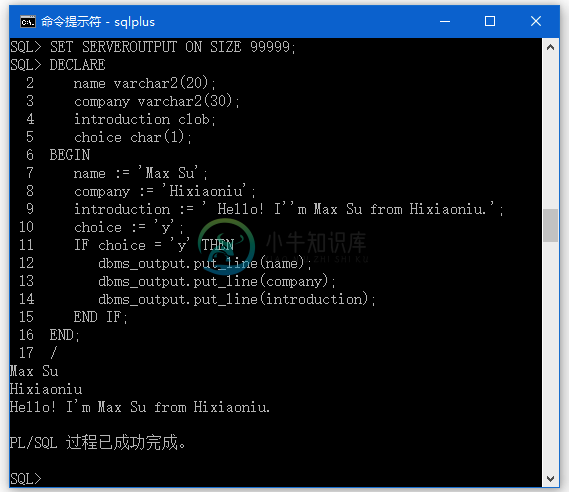PL/SQL字符串
精华
小牛编辑
118浏览
2023-03-14
PL/SQL中的字符串实际上是一个具有可选大小规格的字符序列。字符可以是数字,字母,空白,特殊字符或全部的组合。 PL/SQL提供三种字符串 -
- 固定长度字符串 - 在这样的字符串中,程序员在声明字符串时指定长度。该字符串的右边填充规定的长度。
- 可变长度字符串 - 在这样的字符串中,指定字符串的最大长度达
32,767,并且不会填充。 - 字符大对象(CLOB) - 这些可变长度字符串最多可达
128TB。
PL/SQL字符串可以是变量或文字。 字符串文字用引号括起来。 例如,
'This is a string literal.'
--或者
'hello world'
要在字符串文字中包含单引号,需要在彼此之间键入两个单引号。 例如,
'this isn''t what it looks like'
声明字符串变量
Oracle数据库提供了许多字符串数据类型,如:CHAR,NCHAR,VARCHAR2,NVARCHAR2,CLOB和NCLOB。 以“N”为前缀的数据类型为“国家字符集”数据类型,用于存储Unicode字符数据。
如果需要声明一个可变长度的字符串,则必须提供该字符串的最大长度。例如,VARCHAR2数据类型。 以下示例说明声明和使用一些字符串变量 -
SET SERVEROUTPUT ON SIZE 99999;
DECLARE
name varchar2(20);
company varchar2(30);
introduction clob;
choice char(1);
BEGIN
name := 'Max Su';
company := 'Hixiaoniu';
introduction := ' Hello! I''m Max Su from Hixiaoniu.';
choice := 'y';
IF choice = 'y' THEN
dbms_output.put_line(name);
dbms_output.put_line(company);
dbms_output.put_line(introduction);
END IF;
END;
/
当上述代码在SQLPlus提示符下执行时,它会产生以下结果 -

要声明一个固定长度的字符串,请使用CHAR数据类型。 在这里,不必为固定长度变量指定最大长度。 如果不考虑长度约束,Oracle数据库将自动使用所需的最大长度。以下两个声明是相同的 -
red_flag CHAR(1) := 'Y';
red_flag CHAR := 'Y';
PL/SQL字符串函数和运算符
PL/SQL提供用于连接两个字符串的级联运算符(||)。 下表提供了PL/SQL提供的字符串函数 -
| 编号 | 函数 | 描述 |
|---|---|---|
| 1 | ASCII(x); |
返回字符x的ASCII值。 |
| 2 | CHR(x); |
返回ASCII值为x的字符。 |
| 3 | CONCAT(x, y); |
连接两个字符串x和y,并返回连接后的字符串。 |
| 4 | INITCAP(x); |
将x中每个单词的初第一个字母转换为大写,并返回该字符串。 |
| 5 | INSTR(x, find_string [, start] [, occurrence]); |
在x字符串中搜索find_string子串并返回找到的位置。 |
| 6 | INSTRB(x); |
返回字符串x在另一个字符串中第一次再现的位置,但返回值(以字节为单位)。 |
| 7 | LENGTH(x); |
返回x中的字符数,也是计算字符串的长度。 |
| 8 | LENGTHB(x); |
返回单字节字符集的字符串长度(以字节为单位)。 |
| 9 | LOWER(x); |
将x字符串中的字母转换为小写,并返回此小写字符串。 |
| 10 | LPAD(x, width [, pad_string]) ; |
使用空格垫放在x字符串的左边,以使字符串的长度达到宽度字符。 |
| 11 | LTRIM(x [, trim_string]); |
修剪x字符串左边的字符。 |
| 12 | NANVL(x, value); |
如果x匹配NaN特殊值(而不是数字),则返回值,否则返回x字符串。 |
| 13 | NLS_INITCAP(x); |
与INITCAP(x)函数相同,只不过它可以使用NLSSORT指定的其他排序方法。 |
| 14 | NLS_LOWER(x) ; |
与LOWER(x)函数相同,除了可以使用NLSSORT指定的不同排序方法。 |
| 15 | NLS_UPPER(x); |
与UPPER()函数相同,除了可以使用NLSSORT指定的不同排序方法。 |
| 16 | NLSSORT(x); |
更改排序字符的方法。必须在任何NLS()函数之前指定; 否则,将使用默认排序。 |
| 17 | NVL(x, value); |
如果x为null则返回value值; 否则返回x。 |
| 18 | NVL2(x, value1, value2); |
如果x不为null则返回值value1; 如果x为null,则返回value2。 |
| 19 | REPLACE(x, search_string, replace_string); |
在x字符串中搜索search_string并将其替换为replace_string。 |
| 20 | RPAD(x, width [, pad_string]); |
使用空格垫放在x字符串的右边,以使字符串的长度达到宽度字符。 |
| 21 | RTRIM(x [, trim_string]); |
从右边修剪x字符串。 |
| 22 | SOUNDEX(x) ; |
返回一个包含x的语音表示的字符串。 |
| 23 | SUBSTR(x, start [, length]); |
返回x字符串从指定start位置开始到一个可选指定长度(length)范围内的子字符串。 |
| 24 | SUBSTRB(x); |
与SUBSTR()相同,除了参数以字节表示,还支持单字节字符系统的字符。 |
| 25 | TRIM([trim_char FROM) x); |
修剪x字符串的左边和右边的字符。 |
| 26 | UPPER(x); |
将x中的字母转换为大写,并返回此大写后的字符串。 |
现在来看下面几个例子来了解这个概念 -
示例-1
SET SERVEROUTPUT ON SIZE 99999;
DECLARE
greetings varchar2(11) := 'hello world';
BEGIN
dbms_output.put_line(UPPER(greetings));
dbms_output.put_line(LOWER(greetings));
dbms_output.put_line(INITCAP(greetings));
/* retrieve the first character in the string */
dbms_output.put_line ( SUBSTR (greetings, 1, 1));
/* retrieve the last character in the string */
dbms_output.put_line ( SUBSTR (greetings, -1, 1));
/* retrieve five characters,
starting from the seventh position. */
dbms_output.put_line ( SUBSTR (greetings, 7, 5));
/* retrieve the remainder of the string,
starting from the second position. */
dbms_output.put_line ( SUBSTR (greetings, 2));
/* find the location of the first "e" */
dbms_output.put_line ( INSTR (greetings, 'e'));
END;
/
当上述代码在SQLPlus提示符下执行时,它会产生以下结果 -
HELLO WORLD
hello world
Hello World
h
d
world
ello world
2
PL/SQL 过程已成功完成。
示例-2
SET SERVEROUTPUT ON SIZE 99999;
DECLARE
greetings varchar2(30) := '......Hello World.....';
BEGIN
dbms_output.put_line(RTRIM(greetings,'.'));
dbms_output.put_line(LTRIM(greetings, '.'));
dbms_output.put_line(TRIM( '.' from greetings));
END;
/
当上述代码在SQLPlus提示符下执行时,它会产生以下结果 -
